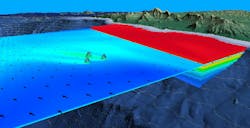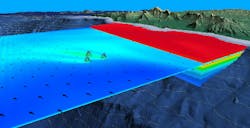Makai launches coastal, ocean modeling tool for large industrial water flows
Sept. 17, 2015 -- Makai, an ocean technology firm based in the state of Hawaii, has announced that it is expanding its environmental and coastal modeling services for clients who discharge into, or withdraw from, the world's oceans, lakes and reservoirs.
Recently, Makai completed an ongoing, 3-year effort totaling $850,000 to adapt the EPA-approved Environmental Fluid Dynamics Code (EFDC) into a robust and flexible dispersion and water quality modeling tool. The new Makai EFDC modeling system (M-EFDC) is specifically designed to simulate and predict the dispersion of large industrial water flows.
Combined with Makai's experienced team, the new M-EFDC enables cost-effective modeling solutions ranging from initial project planning to more rigorous regulatory submittals and watershed management efforts. Likewise, the advanced technology simulates aquatic systems in three dimensions across a wide range of sizes and time-scales.
The model results are used in the design, planning and permitting process for the intake or discharge of a variety of facilities, including: desalination, seawater cooling systems including once-through cooling systems, LNG processing plants, petroleum refineries, traditional thermoelectric power plants, pulp and paper mills, chemical manufacturing plants, food processing plants, and metal manufacturing plants.
Model results help developers to understand and visualize the physical, chemical and biological impacts of their water intake or discharge system. These results are used to decide between design variations or are presented to stakeholders, reducing the uncertainty in the early design and permitting process.
M-EFDC is derived from EFDC, which is one of the most widely used and technically defensible hydrodynamic models in the world over the last 20+ years, and is EPA-approved.
See also:
"Hawaii awarded $1.1 million from EPA to control stormwater runoff"
"Disinfection system amends costs, water quality at Hawaii water recycling plant"
About Makai
Makai Ocean Engineering, Inc. is an ocean technology firm based in the state of Hawaii since 1973. The company's expertise includes submarine cable software and services, marine pipelines, Seawater Air Conditioning (SWAC), Ocean Thermal Energy Conversion (OTEC), underwater vehicles, and general marine engineering and R&D. For more information, visit www.makai.com.
###

